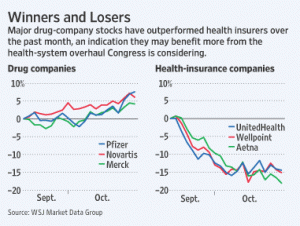 Back in July, before the screaming town hall silliness of Congress’s August recess and before the slow as molasses delivery of Max Baucus’s Senate Finance Committee health care bill, I wrote a piece about how to gauge the progress of health insurance reform legislation. I pointed out that insiders on Wall Street, who have paid for unfair access to our legislators, would know ahead of the curve which way the reform would go. This way they could nearly guarantee that they would not lose money from their investments into the healthcare sector whether reform passed or was defeated. If it looked like reform was imminent, Wall Street would sell their holdings in healthcare companies driving stock prices of insurers down. If the “Street” figured reform would go down in defeat, they’d buy more of the insurers’ stocks as it would be a safe bet that the gravy train would continue for the highly profitable insurance companies. Back in July, the prices of insurance company stocks were surging. The bankers on Wall Street seemed convinced that the public option – the only serious reform device being considered – was all but dead. What does the insurance sector look like today three months later and weeks from the bill’s eventual passage? Follow me over the jump to see.
Well, if like me, you’re a proponent of a strong public option to act as a check against monopolistic price fixing currently perpetrated by the insurance industry for extreme profit at the expense of American lives, you will be pleased to learn this. The stocks of health insurance companies are down and falling as Wall Street believes that a robust reform bill is likely to be passed.
Interestingly, the White House had negotiated with the pharmaceutical industry early in the process. Their deal was basically, in exchange for pharma companies agreeing not to spend millions of dollars on scare campaigns designed to torpedo reform, the government would not include any provisions in the bill allowing price negotiation on drugs. So drug makers will still be allowed to gouge the public even if insurers can’t. As you might expect, the stocks of drug makers have continued to grow. Have a look at this chart from the Wall Street Journal that shows clearly the current trend in stock prices bewteen pharma and insurers. It tells the story clearly.
Back in July, before the screaming town hall silliness of Congress’s August recess and before the slow as molasses delivery of Max Baucus’s Senate Finance Committee health care bill, I wrote a piece about how to gauge the progress of health insurance reform legislation. I pointed out that insiders on Wall Street, who have paid for unfair access to our legislators, would know ahead of the curve which way the reform would go. This way they could nearly guarantee that they would not lose money from their investments into the healthcare sector whether reform passed or was defeated. If it looked like reform was imminent, Wall Street would sell their holdings in healthcare companies driving stock prices of insurers down. If the “Street” figured reform would go down in defeat, they’d buy more of the insurers’ stocks as it would be a safe bet that the gravy train would continue for the highly profitable insurance companies. Back in July, the prices of insurance company stocks were surging. The bankers on Wall Street seemed convinced that the public option – the only serious reform device being considered – was all but dead. What does the insurance sector look like today three months later and weeks from the bill’s eventual passage? Follow me over the jump to see.
Well, if like me, you’re a proponent of a strong public option to act as a check against monopolistic price fixing currently perpetrated by the insurance industry for extreme profit at the expense of American lives, you will be pleased to learn this. The stocks of health insurance companies are down and falling as Wall Street believes that a robust reform bill is likely to be passed.
Interestingly, the White House had negotiated with the pharmaceutical industry early in the process. Their deal was basically, in exchange for pharma companies agreeing not to spend millions of dollars on scare campaigns designed to torpedo reform, the government would not include any provisions in the bill allowing price negotiation on drugs. So drug makers will still be allowed to gouge the public even if insurers can’t. As you might expect, the stocks of drug makers have continued to grow. Have a look at this chart from the Wall Street Journal that shows clearly the current trend in stock prices bewteen pharma and insurers. It tells the story clearly.

Source: WSJ Market Data Group

The problem with a public option is that the government can go into debt and survive, whereas the private sector cannot. What is to prevent the government option from putting the private companies out of business? What is to prevent employers from no longer including health insurance in their employment packages because their is a public option?
I doubt the addition of a non-profit option would result in bankrupting an insurance industry that has been reaping record profits. Will it bring their margins down from the current 30% profitability to a less extravagant level? Probably. But this doesn’t bother me. Will the insurers be run out of business? Hardly! I have heard this concern from many in the course of the debate. Frankly it is the product of fearmongering from an industry desperate to avoid competition and maintain their overinflated profit margins. The same people tried to scare the public in the 60’s when Medicare was being debated saying the same thing, that a non-profit, government administrated health plan would run them out of business. We all know how untrue that position turned out to be. Free marketeers are supposed to extoll the benefits of competition right? Adding choice and competition to the market is best for consumers. Consider the deregulation of the postal service that prompted the rise of “non- goverment administered” delivery companies like UPS and FedEx. The addition of their competition did NOT mean the demise of the US Postal Service. In fact, if anything, it held the USPS to a higher standard of service and quality. And finally, unless you’re a stockholder in health insurers, I wonder why you are so concerned with the profits of private sector organizations? Even if Congress passed a universal single payer plan – which WOULD essentially eliminate private insurance companies – the medical industry would still exist. Doctors, hospitals, pharma companies etc would still be doing the work they do today. What value does the for-profit insurance company add to the delivery of health care to Americans? They are a parasitic middleman that adds nothing of value to the process in my opinion. But I am confident that a public option would not freeze private insurers out. But it would make them think twice about denying coverage and jacking up premiums to stratospheric levels. After all, they wouldn’t want to drive more people to the public plan would they?
“What I find particularly satisfying about the nearly 20% drop in insurers’ stock price is the fact that their profit margins as an industry are estimated at between 20% and 30%”
Have you actually gone online and view the real profit margins that belong to the shareholders of these companies?
Great article!
I completely agree that the recent rise of th insurance industry has certainly negatively affected the private sector. I would like to see some changes made not only in the insurance regulations but on the relgukations concerning pharmaceutical giants.
Thanks again for the post!